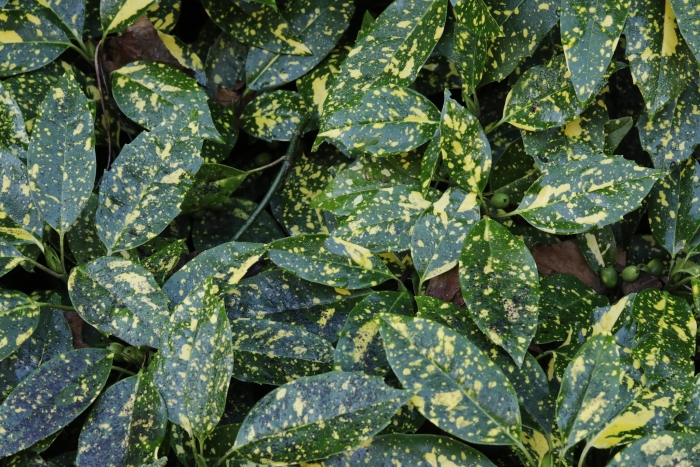Japanese Laurel
(Aucuba japonica)
Japanese Laurel (Aucuba japonica)
/
/

Stephen James McWilliam
Public Domain
Image By:
Stephen James McWilliam
Recorded By:
Copyright:
Public Domain
Copyright Notice:
Photo by: Stephen James McWilliam | License Type: Public Domain | License URL: http://creativecommons.org/publicdomain/zero/1.0/ | Rights Holder: Stephen James McWilliam | Publisher: iNaturalist | Date Created: 2019-12-17T13:56:33-08:00 |












































































Estimated Native Range
Summary
Aucuba japonica, commonly known as Japanese Laurel, is an evergreen shrub native to the understory of moist, rich forest soils in valleys, thickets, and along streams, often near shaded, moist rocks in China, Korea, and Japan. It typically grows 1–5 meters (3.3–16.4 feet) tall and is widely recognized for its glossy green leaves and tolerance of challenging garden conditions. The species is particularly noted for its variegated cultivars. The flowers, which appear in spring, are small, 4–8 mm (0.16–0.31 in) in diameter, with four purplish-brown petals, and are produced in clusters of 10-30 in a loose cyme, though they are not particularly showy. The plant also produces red berries that can be quite ornamental.
Japanese Laurel is valued for its ability to thrive in dry shade, making it an excellent choice for difficult garden spots. It is also resistant to pollution and can tolerate salt-laden coastal winds, which makes it suitable for urban and coastal plantings. Commonly used as an informal hedge, it can also be grown indoors as a houseplant. In cultivation, it prefers part shade to full shade, requires medium amounts of water, and can adapt to a range of soil drainage conditions, from slow to fast. Gardeners should be aware that Aucuba japonica can become invasive outside its native range.CC BY-SA 4.0
Japanese Laurel is valued for its ability to thrive in dry shade, making it an excellent choice for difficult garden spots. It is also resistant to pollution and can tolerate salt-laden coastal winds, which makes it suitable for urban and coastal plantings. Commonly used as an informal hedge, it can also be grown indoors as a houseplant. In cultivation, it prefers part shade to full shade, requires medium amounts of water, and can adapt to a range of soil drainage conditions, from slow to fast. Gardeners should be aware that Aucuba japonica can become invasive outside its native range.CC BY-SA 4.0
Plant Description
- Plant Type: Shrub
- Height: 6-10 feet
- Width: 5-9 feet
- Growth Rate: Moderate
- Flower Color: N/A
- Flowering Season: Spring
- Leaf Retention: Evergreen
Growth Requirements
- Sun: Part Shade, Full Shade
- Water: Medium
- Drainage: Slow, Medium, Fast
Common Uses
Bank Stabilization, Bird Garden, Border Plant, Deer Resistant, Drought Tolerant, Erosion Control, Hedges, Low Maintenance, Potted Plant, Salt Tolerant, Street Planting
Natural Habitat
Understory of moist, rich forest soils in valleys, thickets, and along streams in China, Korea, and Japan
Other Names
Common Names: Spotted-Laurel, Japanese Aucuba, Gold Dust Plant, Aukube, Broodboom, Aukuba, 東瀛珊瑚;青木, Aoki, 식나무, Aucuba
Scientific Names: , Aucuba japonica, Aucuba vivicans,
GBIF Accepted Name: Aucuba japonica Thunb.